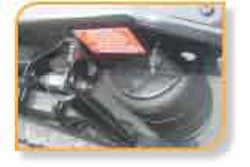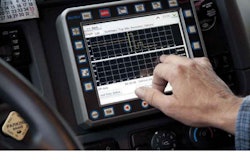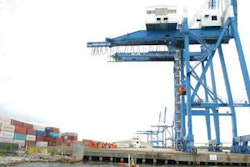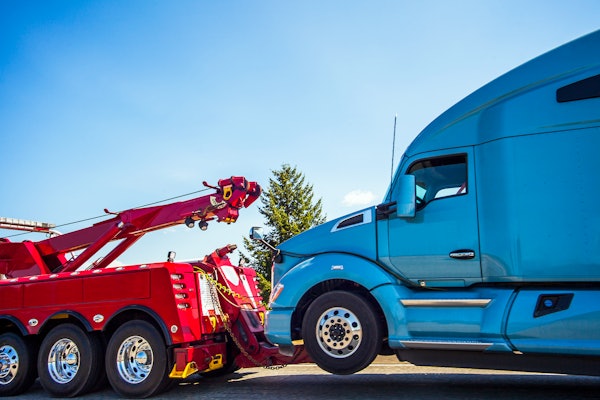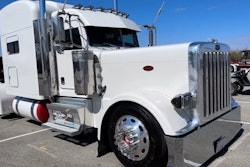Manufacturers say EPA-driven changes yield better fuel economy and other benefits.
The 2010 drop in NOx to 0.2 grams has been accomplished by most truck makers with selective catalytic reduction. Even with SCR’s requirement for adding diesel exhaust fluid, SCR has brought basic improvements.
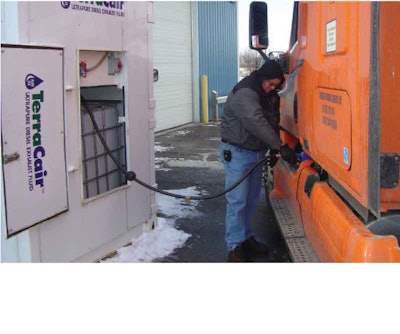 Steve Duley of Schneider reports only one incident of DEF going into the diesel tank, and the problem was fixed with minimal downtime. It happened because the restrictor in the filler neck had fallen out.
Steve Duley of Schneider reports only one incident of DEF going into the diesel tank, and the problem was fixed with minimal downtime. It happened because the restrictor in the filler neck had fallen out.That’s because letting SCR handle much of the NOx means less exhaust gas recirculation. Reducing EGR means the cylinders will need to contain less pressure, inviting modest performance and fuel economy improvements.
Torque curves are improved, too. Schneider National Vice President of Purchasing Steve Duley notes that “the engine manufacturers have taken advantage of having injection pressure available at any time during or after the compression stroke. Drivers report better acceleration and quieter running engines… Drivers like the power and overall performance.”
In Cummins’ case, the reduction in the amount of air plus exhaust needed is compounded by the adoption of the new XPI, high-pressure common rail injection system for 2010. Unlike unit injectors, the common-rail system provides whatever injection pressure is needed even at low rpm.
“With the rocker actuation of injectors in the past,” says Zack Ellison, Cummins’ technical director of customer support, “we had to tune the rocker lever for system performance in a way that gave less than optimum performance at low rpm” because of reduced atomization.

The result, says Ellison, is the ability to produce more torque at a lower rpm, and a more favorable torque curve, which “reduces the need to downshift.” He says peak torque is maintained down to 1,100 rather than 1,200 rpm on many of the ratings. So while Cummins has not introduced higher maximum power or torque ratings, an engine at a given rating will pull better and feel more powerful. They have, however, enhanced the number of SmartTorque ratings – 200 lb.-ft. of additional torque that shows up in the top two gears, giving drivers an incentive not to downshift.
Daimler Trucks made “no fundamental changes from EPA07 to EPA10” in engine power ratings for its Detroit Diesels, says Brad Williamson, engine and component marketing manager. “We have biased all benefits toward gains in fuel economy and durability.”
Mack’s David McKenna, director of powertrain sales and marketing, says EGR flow rates in 2010 engines are down to EPA02-like “light EGR” levels. “The peak power on the Mack MP8 engine has jumped from 485 to 505 hp, and from 1,660 lb.-ft. of torque to 1,760, with lower rejected heat. If you look back, each time the heavy-duty diesel industry has increased EGR flow rates, fuel economy suffered significantly. Mack ClearTech SCR reverses this trend.”
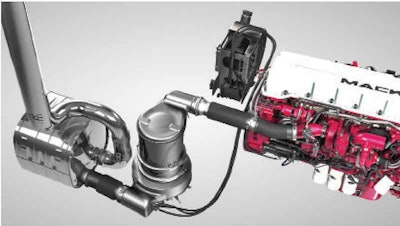 Mack’s DPF and SCR system is unusually compact, with a vertical DPF, a layout shared with Volvo on some models of either truck brand.
Mack’s DPF and SCR system is unusually compact, with a vertical DPF, a layout shared with Volvo on some models of either truck brand.International’s Tim Shick, director of marketing for MaxxForce engines, the only on-highway engines not utilizing SCR technology to meet the 2010 standards, says the Big Bore engine’s maximum rating remains at 475 hp at 1,700 lb.-ft. Its performance curves have not changed.
However, the company has also introduced two multi-torque ratings – 430 hp with 1,550/1,750 lb.-ft and 450 hp with 1,550/1,750 lb.-ft. Although the base ratings remain the same, other changes like higher injection pressure and an improved charge air cooler mean the engine is “if anything, even more responsive than before,” Shick says.
Volvo’s Jim Fancher, powertrain product marketing manager, notes a power boost along with a reduction in the amount of cooled exhaust gas added to the mixture. “This decrease in exhaust gas results in a more efficient combustion event, yielding improved fuel efficiency, and an increase in horsepower/liter density. The decrease in exhaust gas also reduces the amount of ambient heat that must be dispersed.”
“Prior to EPA10,” he adds, “the maximum horsepower produced by [the D13] was 485 with 1,650 lb.-ft. of torque.” Today, the engine is capable of 500 hp with 1,750 lb.-ft. of torque.
The 2010 fuel economy improvements are best viewed alongside diesel exhaust fluid (DEF) consumption rates, given that any boost in the former will be tempered by the necessity of buying the latter.
“The price of bulk DEF is relatively close to the price of diesel, or a little less,” says Duley. “We’d rather have to use a gallon of DEF to save a gallon of fuel. The 2010 trucks have shown about a 5 percent improvement in diesel fuel consumption, although some manufacturers are better than others. DEF consumption rates vary by manufacturer, too, between 2 and 4 percent, so we watch that carefully.”
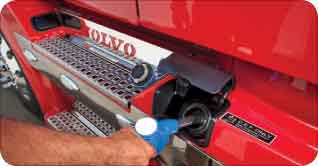 DEF tanks are clearly marked and won’t accept a diesel fuel pump nozzle, so the addition of diesel fuel to DEF tanks is rare.
DEF tanks are clearly marked and won’t accept a diesel fuel pump nozzle, so the addition of diesel fuel to DEF tanks is rare.Fancher reports an average 5 percent fuel economy improvement with Volvo engines, compared to 2007. One carrier making dedicated runs owns five Volvos, he says, “three of which are 2011 VN670s with D13 425-hp SCR engines. He says his uptime with these units is greatly improved and his fuel economy is close to the 7.0 mpg mark, an almost 10 percent improvement over his older units.”
A 150-truck fleet in Alabama ordered one VNL630 with a D13 475-hp SCR engine as a test in January 2010. “It’s been running problem-free all that time and is delivering about a half mile per gallon better fuel economy than the rest of their trucks,” Fancher says.
Ellison gave an example of an over-the-road truck, comparing similar 2009 and 2010 Cummins engines. The truck could easily reduce fuel consumption by 6 percent and need 2 percent of total fuel in DEF, which would end up costing about $600 per year per truck. The net savings would approach $2,800 per truck per year.
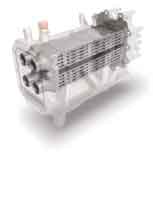 International’s EGR cooler has an unusual floating core.
International’s EGR cooler has an unusual floating core.Williamson says Detroit Diesel customers are reporting “up to 5 percent better fuel economy compared to 2007,” which the company promised. “Our customers have also commented on exhaust fluid consumption being in line with estimates of 2 percent of diesel fuel.”
Mack’s also seeing a “solid 5 percent improvement in fuel economy,” says McKenna. “We predicted DEF consumption at a rate of 3 percent relative to the diesel fuel. We are actually seeing something closer to 2.2 percent overall – slightly higher with winter grade fuel.”
While one might expect higher levels of regeneration from International than competitors’ vehicles with their lower engine-out NOx, Shick says the materials used in its diesel particulate filter have been changed to keep the unit hotter, and exhaust temperature can also be ramped up to help keep the unit clear. The ECM watches soot-related backpressure and controls the interstage cooler and an exhaust brake that remains on the engine to heat up the exhaust and avoid the need for active regeneration under many conditions.
He adds it also helps that the engine delivers “full torque at 1,000 rpm. Our customers have experienced the same or better fuel economy in every application,” Shick says. “This is beause our engine is integrated into the truck, and we’ve made aerodynamic improvements, reduced weight, and reduced parasitic losses, for example by adopting a clutched air compressor that shuts down once the air brake pressure has reached the cutoff point.” With no DEF, this should mean low operating costs.
The added weight of SCR components is an issue for all makers but International. Duley says, “With all of the emission components we have added over the last few years, there has been an overall increase in weight, and that weight tends to be toward the steer axle. The 13,000-pound axle and properly rated tires give that extra margin that could keep you out of trouble.”
Contrasting 2009 weight with that of the current setup, Ellison says, Cummins took 70 pounds out of the engine by removing the injector camshaft. He estimates DEF weight at 162 pounds with an 18-gallon tank. Cummins’ specification for the 2010 aftertreatment system weight is 202 pounds. But if the total cost of fuel plus DEF drops as significantly as is claimed, and maintenance costs decline as well, the end result could be a more profitable operation, even with a small decrease in payload.
Oil change intervals getting longer
It’s too early to tell what the ultimate maintenance picture on selective catalytic reduction engines will be, but prospects for extending oil change intervals appear to be improving.
Schneider National’s Steve Duley says the fleet’s oil analysis results for the 2010 engines show a “slightly diminished soot production rate. In the environment we run, our engines don’t have a tremendous appetite for TBN and we don’t see a lot of oxidation forming even as we push out to very high drain mileages.” TBN (total base number) measures the ability of the oil to combat acid. If TBN remains high enough, the oil is still protecting the engine.
“Wear rates are still quite low, which is different from engines from the early ‘90s, but the 2010 drains we run are at or greater than the 2007 product,” Duley says.
Volvo’s Jim Fancher says oil degrades “at a slower rate with the new emissions system.” However, he adds, “With our 2007 engine, Volvo extended oil change intervals from 20,000 to 35,000 miles in a normal application. We maintained this 35,000 interval on our 2010 engines.”
Mack’s David McKenna says the introduction of ultra-low sulfur diesel fuel for 2007 “helped offset some of the impact of increased EGR flow rates. We are reviewing 2010 data to determine if drain intervals can be extended, with a decision expected around mid-year.”
McKenna cautions that oil analysis alone shows a limited picture of the difference between 2007 and 2010. “Soot accumulation is very low in both and the effects on viscosity should be similar, perhaps with a slight reduction in TBN depletion for 2010. No change whatsoever with coolant conditioning. But, fan on-time has been reduced as a direct result of less EGR. Additionally, we now have a heavy-duty multi-speed fan drive as standard equipment on the Mack Pinnacle. This has resulted in a considerable improvement in drive belt wear and tensioner life.”
Cummins’ Zack Ellison also notes that while the company has not modified its oil change interval recommendations yet, “analysis reports do show that TBN depletion rates are just a little lower. The factory Cummins Filtration filters were optimized for the 2007 engines by altering the flow rates through the full-flow and bypass filers slightly. With better engine tuning, there’s less unburned hydrocarbon in the oil in 2010 — a prime contributor to plugging in the past.”
Daimler Trucks’ Brad Williamson reports the company’s 2010 Detroit Diesel engines are “a benchmark with a 50,000-mile service interval. We will continue to press ahead on longer service intervals and reduction of environmental impact from used engine oil and filters.”
He says the company’s seen no particular concerns with maintenance stemming from the 2010 SCR technology, though customers’ use of counterfeit Detroit Diesel oil filters has “created several non-warrantable engine failures.”
Optimized 2010 timing rejects less heat, too, Ellison says. “There’s been no change in radiator capacity, but now there is more reserve. With the latest coolants, and mid-stop cylinder liners, cavitation is something we rarely hear about any more.”
Ellison also notes that Cummins’ interval for cleaning the doser inector has risen from 125,000 to 150,000 miles. “In many applications, there’s no [diesel particulate filter] regeneration, so soot clogging of the nozzle is less and less common.”
Volvo’s coolant life, performance and service interval are unchanged, Fancher says, but “our EPA10 engines are experiencing a decrease in fan-on time because of the decrease in thermal cycling resulting from the reduction in EGR rates.”
International’s Tim Shick reports the MaxxForce Big Bore’s oil change interval, for highway engines getting 6.5 mpg, has been lengthened from 25,000 miles to 40,000 because of the addition of a Spinner centrifugal filter to remove soot. Also, the cam cover, removed every 250,000 miles to adjust the overheads, is now much easier to access.
The dosing nozzle for the DPF has also been moved to a spot where it is subject to less heat, reducing coking. This eliminates the former requirement to clean it every 100,000 miles.
A different approach to 2010
International designed its MaxxForce Big Bore engines with no selective catalytic reduction. It set its initial NOx levels at 0.5 grams, burning credits with the U.S. Environmental Protection Agency to exceed EPA’s 0.2 grams mandate.
Many experts believe that high levels of EGR tend to compromise performance. But International’s Tim Shick lists design aspects that improve performance.
The first is “an advanced turbocharging system that drives in lots of cool, clean air plus exhaust,” Shick says. Interstage cooling removes heat from the air discharged by the primary turbo before it arrives at a secondary unit. The interstage cooler uses engine coolant that’s well below operating temperature. Removing heat from the partially compressed air means the high-pressure turbo can compress the charge to a higher pressure with less horsepower and backpressure.
Although the injection system does not “run higher pressures than the industry has used historically,” he says, pressure has been increased from about 26,000 psi prior to 2010 to 32,000 psi today. The fact that the engine uses a common-rail design where “you can run full pressure at low speed,” even below the 1,000 rpm torque peak, greatly reduces soot production.
International also uses a proprietary combustion bowl. The shape is more complex, and combines with “the number of holes and spray angle, the bore size, the boost levels, and the fuel pressure, to produce inherently low emissions,” he says.
Another feature is an unusual exhaust gas recirculation cooler. Although EGR levels have been increased only “incrementally, about 3 to 5 percent,” according to Shick, the cooler has a very high capacity and brings recirculated exhaust down to “below 200 degrees.”




